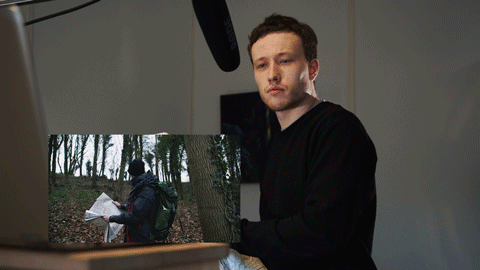Foley is the dark horse of filmmaking. It turns your film from “pretty good” to “polished”.
After creating foley for the last 5 films on this channel, I’ve learned a few tricks which will help YOU record some great foley for your films. Welcome to The Film Look.
Number one: footsteps are never alone.
If you’ve done any foley for your film, I imagine you’ve recorded or edited some footstep sounds. Footsteps are the most obvious run-of-the-mill sound effects to add into your scene, and usually I will tackle these first, but they always sound better when they are layered with other foley.
What I like to do is breakdown the possible sound elements associated with each character in the scene. Let's take this example called “Lost in the Forest” which we filmed for this foley series!
The character produces sounds from his footsteps, his coat, his backpack, and his map. These are all moving as he walks and they will produce their own sound effects, so if we record each of them and layer them into the scene, it turns it from this into this.
Which brings me onto Number two: how to record clothing foley!
When I first started recording foley, I used to wear the clothing and try to move around and mimic the character on screen. This doesn’t produce a clear enough sound to layer in with everything else. I found you need to exaggerate the noise to be effective.
So take off the coat and bunch it up into a loose ball in front of the mic. Instead of mimicking the actual steps, just mimic the swing and movement of the character.
The clothing will produce some unique sounds depending on how you handle it, so experiment and try to find something which fits the scene.
Number three: accurate handling!
The next thing we need to record is the paper map. A prop like this can produce a million and one different sounds just by the way it's being handled. A map being crushed sounds very different to a map being folded, so this is where accurate mimicking comes in!
If the character has the map out on display and is climbing down the hill, mimic that movement as close as you can by opening up the map and lightly bounce it up and down. If the character holds the map out and swings it, do the same thing. Don’t record generic foley; it never sounds good! Get particular and mimic the actions as accurately as possible.
Number four: beefing up the props!
With something like a backpack, it would be easy enough to grab an empty rucksack and shake it around in time with the character on screen. This may sound okay, but it doesn’t sound at all interesting.
Instead, you can beef up the sound of the prop by adding weight. This will help create a great sound when it swings around because of things like velocity and inertia.
That’s right - science is audible!
Then, add some items inside it. For rucksack sounds, I like to take a set off mess tins and place them at the top of the pack. They will rattle around and add some extra dynamic kinetic audio.
And if the straps are producing an annoying flappy sound when you record, just tuck them in! Sound design is your choice, so if you find the sound can be annoying, chances are the audience will find it annoying too.
Number five: environmental interaction
If your character interacts with the environment, nine times out of ten it will produce a sound, so don’t ignore these!
In the scene “Lost in the forest” you can clearly see our character causing a bunch of dry leaves to roll down the hill as he steps down. Yes, we have footstep sounds, but the sound of leaves falling down a hill will produce something very different. So grab some dead leaves, dry them out, and record brushing and moving them with your hand. This subtle sound effects will really help sell the effect that the audio is real.
Number six (bonus): Don’t forget your atmos!
The final element to add into a scene to help ground in reality and trick the audience into believing these sounds were recorded on the day is the ambient noise from the location. If it’s inside you can use room tone, and if it’s outside, you’ll need some atmos.
For the “Lost in the Forest” scene we recorded atmos at the location but it sounded horrible. That horrible droning wind is actually the sound of the cars on the motorway over a mile away. So instead, I found a track from https://freesound.org/people/bajko/
Adding atmos into the scene will help smooth over the otherwise moments of silence between sound effects.
🚀 https://www.thefilmlook.com/store - Step up your sound game with our FOOTSTEPS SOUND PACK. It features 200+ sounds, 9 surfaces, and 6 types of footwear, perfect for your next film project.
🎬 In case you missed it
How to Build a DIY Foley Pit: https://youtu.be/zO2hx7iToNY
$600 Mic vs $60 Mic: https://youtu.be/2VK6lYkK2AM
How to Mix Sound for a Short Film: https://youtu.be/7x5SnoftgUw
How to Record BETTER Footstep Sound Effects: https://youtu.be/vQ8bnF-OWSA
🎥 This episode's kit/gear/equipment:
US links:
The Sound Effects Bible: https://amzn.to/2sSWEUy
UK links:
The Sound Effects Bible: https://amzn.to/2DD9ZXc
DISCLAIMERS:
Some of these links are affiliate links, if you purchase gear via these links The Film Look will receive a small commission, but there will be no additional cost to you. Thank you!











